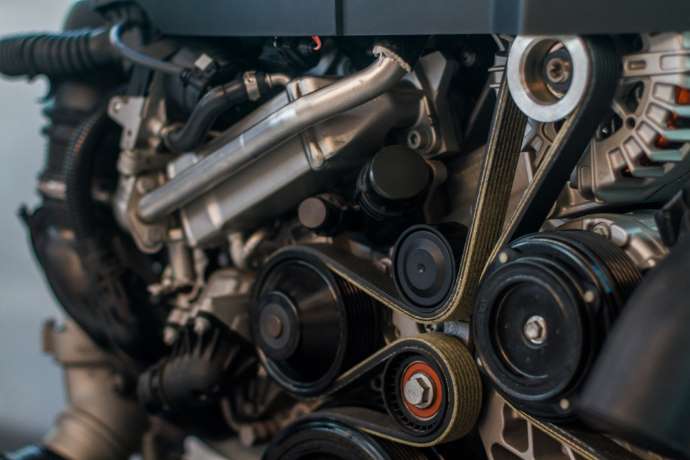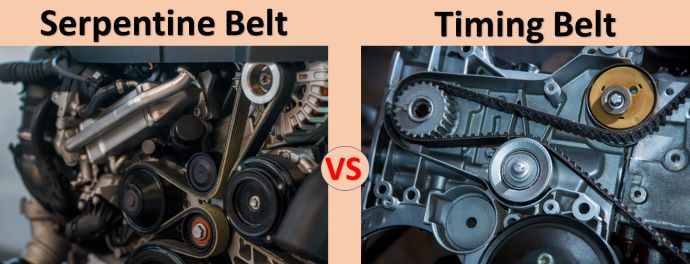A car has a lot of parts, and it’s impossible to remember all of their names and what they do.
The timing belt and the serpentine belt are these types of components.
Even though there are many differences between the belts, some users think they’re the same.
Both belts are crucial for the vehicle’s engine and other parts to run smoothly.
Timing and serpentine belts serve different purposes, and they are situated and used differently.
I have written this article to help you understand the distinctions between timing and serpentine belts.
What is a Timing Belt on a Car?
A timing belt is a rubber toothed that connects the crankshaft and camshaft.
The timing belt is a crucial part of a vehicle’s engine that helps the crankshaft and camshaft rotate properly.
What is a Serpentine Belt on a Car?
A serpentine belt is a long, continuous rubber belt that drives many parts of the engine, like the alternator, air conditioner, water pump, power steering pump, etc.
It is typically made from reinforced rubber, which provides strength and durability to the belt.
The belt is called “serpentine” because of its snake-like structure.
What does the Serpentine Belt Do in a Car?

The serpentine belt drives many important car parts, like an alternator, power steering pump, water pump, AC compressor, cooling fan, etc.
Alternators charge the battery, water pumps circulate coolant, power steering pumps turn the steering wheel, and air conditioners keep the interior cool.
Serpentine belts are crucial for the smooth operation of all these components.
A broken or worn serpentine belt can make all the important parts stop working or even stop altogether.
That is why, during regular maintenance, inspecting the serpentine belt is important.
What does the Timing Belt Do in a Car?

The timing belt is an essential component of an engine that coordinates the rotation of the camshaft and the crankshaft.
The camshaft is responsible for the engine’s valve opening and closing.
While the crankshaft generally converts the piston’s linear motion into rotational motion.
A timing belt ensures that the camshaft and crankshaft function properly.
Therefore, the engine pistons work correctly, and the valves are opened and closed timely.
If the timing belt is faulty, it reduces engine performance and causes damage to the engine.
Serpentine Belt Vs Timing Belt [6 Differences and Similarities]
Serpentine and timing belts are two different types of belts that perform different functions, have different prices and repair costs, have different compositions, make different noises, etc.
1. Function
The serpentine belt is a belt that is used to drive multiple components, such as the alternator, water pump, AC compressor, power steering pump, cooling fan, etc.
In contrast, a timing belt ensures that the crankshaft and camshaft rotate at the same rate.
2. Serpentine Belt Vs Timing Belt Cost

Depending on the vehicle’s model and year, a serpentine belt costs around $20 to $100.
In contrast, the current price of a timing belt is around $300 to $400 in the USA.
A timing belt costs around $280 to $300 more than a serpentine belt.
3. Serpentine Belt Vs Timing Belt Chain
From the surface of the serpentine belt and timing belt, it is easier to differentiate them.
In serpentine belts, V-shaped grooves run vertically along their surface.
In contrast, the timing belt features horizontal teeth that fit into the cogwheels of the camshaft and crankshaft.
4. Serpentine Belt Vs Timing Belt Noise

Both the serpentine belt and timing belt produce noise when they are worn out or damaged.
But if we look at noise and compare serpentine and timing belts, the timing belt makes more noise when it is worn or damaged.
The timing belt is connected to the engine’s valve and pistons, so if it is damaged, the valve will open and close at the wrong time.
Therefore, the engine will produce more noise.
5. Serpentine Belt Vs Timing Belt Repair Cost
If the serpentine belt or timing belt is worn or damaged, it is best to replace it instead of trying to fix it.
Most of the time, the cost to replace the serpentine and timing belts depends on the make and model of the car.
Serpentine belt parts cost around $60 to $80, and labor costs about $50 to $70.
So, replacement costs range from $60 to $80 if you do it yourself and from $110 to $150 if you hire an auto mechanic.
In contrast, replacing the timing belt is a complex process and requires experience.
However, if you can replace the timing belt yourself, it costs around $260 to $350 (DIY cost).
When hiring an auto mechanic, the timing belt replacement cost will increase by approximately $360 to $590.
6. Serpentine Belt Vs Timing Belt Composition
Fiberglass-reinforced or neoprene rubber is used to make the timing belt, while polymer-based rubber is used to make the serpentine belt.
Therefore, the serpentine belt is usually soft and elastic, which allows it to rotate multiple accessories efficiently using a single belt.
Serpentine Belt or timing Belt Which is Better?
The timing and serpentine belts are important for the engine to run smoothly.
However, they are used in different sectors and have different roles.
The timing belt ensures the intake and exhaust valves open and close at the right times.
On the other hand, the serpentine belt ensures that the engine’s other parts, like the water pump, alternator, and air conditioner, work well.
So, comparing the two belts based on which is better is unfair.
FAQs
Is a Serpentine Belt the Same as a Timing Belt?
No, the serpentine belt is not the same as the timing belt.
Timing and serpentine belts differ in functions and structures.
What happens to a car when the serpentine belt breaks?
Several problems occur when the serpentine belt breaks, including:
- The alternator doesn’t work.
- The battery doesn’t charge.
- The air conditioning stops functioning.
- The power steering pump stops functioning.
- The water pump fails to work properly and causes the engine to overheat.
Does serpentine belt affect timing?
No, the serpentine belt and timing belt are separate, so a damaged serpentine belt won’t affect the timing belt.
Thus, a loose serpentine belt will not affect engine timing.
What is another name for a timing belt?
The timing belt is a wide rubber belt that helps the crankshaft turn the camshaft.
The other names for a timing belt are camshaft drive belt, cambelt, timing chain, or Gilmer belt.
How much is it to replace a timing or serpentine belt?
Replacing the timing belt costs around $360 to $590, including labor costs.
In contrast, replacing the serpentine belt costs around $110 to $150, including labor costs.
Timing belt replacement is a complex procedure.
Therefore, the timing belt is more expensive than a serpentine belt replacement.
What is another name for serpentine belt?
The serpentine belt is also known as an accessory belt or fan belt.
In addition, some also call it an alternator belt or drive belt.
This is because the serpentine belt is used to drive multiple accessories.
Final Thoughts
Timing belts and serpentine belts for cars are both crucial.
Both belts rotate a car’s parts; they operate in various locations and serve different purposes.
That’s why they differ in price, repair cost, and composition.
If the serpentine belt fails, it causes multiple accessories to fail.
In contrast, a failed timing belt can cause significant damage to the engine.
A car will run smoothly if the serpentine and timing belts are in good shape.
Maintaining your timing and serpentine belts on a regular basis will keep your car’s system working properly and save you money on repairs.
Read more:


